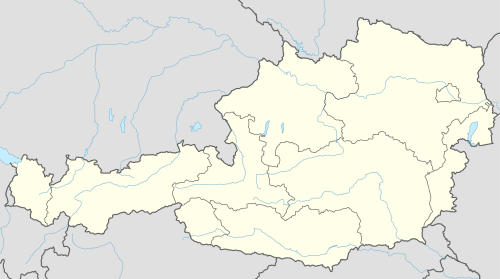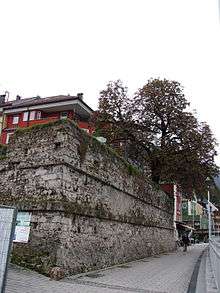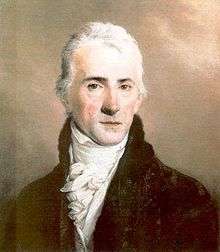Kufstein
| Kufstein | ||
|---|---|---|
|
View to Kufstein Fortress and Brandenberg Alps | ||
| ||
 Kufstein Location within Austria | ||
Location within Kufstein district
| ||
| Coordinates: 47°35′00″N 12°10′00″E / 47.58333°N 12.16667°ECoordinates: 47°35′00″N 12°10′00″E / 47.58333°N 12.16667°E | ||
| Country | Austria | |
| State | Tyrol | |
| District | Kufstein | |
| Government | ||
| • Mayor | Martin Krumschnabel (Independent) | |
| Area | ||
| • Total | 39.37 km2 (15.20 sq mi) | |
| Elevation | 499 m (1,637 ft) | |
| Population (1 January 2016)[1] | ||
| • Total | 18,726 | |
| • Density | 480/km2 (1,200/sq mi) | |
| Time zone | CET (UTC+1) | |
| • Summer (DST) | CEST (UTC+2) | |
| Postal codes | 6330-6333 | |
| Area code | 05372 | |
| Vehicle registration | KU | |
| Website | www.kufstein.at | |
Kufstein (Central Bavarian: Kufstoa) is a town in the Austrian state of Tyrol, the administrative seat of Kufstein District. With a population of about 18,400, it is the second largest Tyrolean town after the state capital Innsbruck. The greatest landmark is Kufstein Fortress, first mentioned in the 13th century.
Geography
It is located in the Tyrolean Unterland region on the river Inn, at the confluence with its Weißache and Kaiserbach tributaries, near the border to Bavaria, Germany. The municipal area stretches along the Lower Inn Valley between the Brandenberg Alps in the northwest and the Kaiser Mountains in the southeast. The remote Kaisertal until recently was the last settled valley in Austria without transport connections, prior to the construction of a tunnel road from Kufstein to neighbouring Ebbs in 2006. North of the town, the Inn river leaves the Northern Limestone Alps and enters the Bavarian Alpine Foreland. The town area comprises several small lakes, such as Pfrillsee, Längsee, and Hechtsee; Egelsee and Maistaller Lacke are protected nature reserves.
The municipal arrangement comprises the cadastral communities of Kufstein, Mosbach and Thierberg; the town itself is divided into five quarters (Zentrum, Sparchen, Weissach, Endach, and Zell).
Climate
| Climate data for Kufstein | |||||||||||||
|---|---|---|---|---|---|---|---|---|---|---|---|---|---|
| Month | Jan | Feb | Mar | Apr | May | Jun | Jul | Aug | Sep | Oct | Nov | Dec | Year |
| Average high °C (°F) | 2 (36) |
5 (41) |
10 (50) |
14 (57) |
19 (66) |
21 (70) |
24 (75) |
23 (73) |
19 (66) |
14 (57) |
7 (45) |
3 (37) |
13.4 (56.1) |
| Average low °C (°F) | −4 (25) |
−3 (27) |
0 (32) |
3 (37) |
8 (46) |
11 (52) |
13 (55) |
13 (55) |
10 (50) |
5 (41) |
0 (32) |
−3 (27) |
4.4 (39.9) |
| Average precipitation mm (inches) | 81 (3.19) |
72 (2.83) |
93 (3.66) |
95 (3.74) |
110 (4.33) |
155 (6.10) |
175 (6.89) |
153 (6.02) |
102 (4.02) |
73 (2.87) |
95 (3.74) |
88 (3.46) |
1,292 (50.85) |
| Source: SmartTripWeather[2] | |||||||||||||
Population
| Historical population | ||
|---|---|---|
| Year | Pop. | ±% |
| 1869 | 2,777 | — |
| 1880 | 3,787 | +36.4% |
| 1890 | 4,067 | +7.4% |
| 1900 | 4,791 | +17.8% |
| 1910 | 6,717 | +40.2% |
| 1923 | 7,103 | +5.7% |
| 1934 | 7,551 | +6.3% |
| 1939 | 8,233 | +9.0% |
| 1951 | 11,268 | +36.9% |
| 1961 | 11,215 | −0.5% |
| 1971 | 12,913 | +15.1% |
| 1981 | 13,118 | +1.6% |
| 1991 | 13,484 | +2.8% |
| 2001 | 15,358 | +13.9% |
| 2011 | 17,388 | +13.2% |
| 2015 | 20,064 | +15.4% |
Economy
Glass manufacturer Riedel, gunmaker Voere, and ski and tennis racket manufacturer Kneissl are based in Kufstein.
Kufstein is also home to the University of Applied Sciences Kufstein which specializes in providing business education and is a center for international exchange.
Transport

Kufstein has two exits along the A12 motorway (autobahn) from Innsbruck to Rosenheim.
Kufstein railway station, opened in 1876, forms part of the Lower Inn Valley railway section of the Brenner-axis from Munich to Verona.
The Festungsbahn is a funicular that links the city centre with the Kufstein Fortress.
History
Archaeological findings in the Tischofer Cave in Kaisertal denote a settlement of the area more than 30,000 years ago, the oldest traces of human habitation in Tyrol. Incorporated into the Roman Empire in 15 BC, the Inn river formed the border between the Roman provinces of Raetia and Noricum.
A church at Caofstein was first mentioned in a 788 deed issued by Bishop Arno of Salzburg. At that time, the Lower Inn Valley was part of the Bavarian realm under the Agilolfing duke Tassilo III, who was deposed by Charlemagne and replaced by Prefect Gerold. The Fortress is first documented in 1205 as a possession of the Bishop of Regensburg and the Duke of Bavaria.
In the early 14th century, the Wittelsbach emperor Louis IV, also Bavarian duke, vested the Kufstein citizens with rights of jurisdiction. Kufstein passed to the County of Tyrol in 1342, when it was a wedding gift to Countess Margaret from her husband, Emperor Louis's son Louis the Brandenburger. However, it fell back to Bavaria upon Margaret's death in 1369. Duke Stephen III of Bavaria granted Kufstein city status in 1393, due to its prominence as a trading and docking point on the Inn River.[3] From 1415 onwards, his son and successor Duke Louis VII had the Fortress largely rebuilt and expanded.

The possession of the strategically important Kufstein border fortress remained disputed. In 1504, the Habsburg emperor Maximilian I took the opportunity of the War of the Succession of Landshut within the Bavarian Wittelsbach dynasty: his Austrian forces laid siege to the town, and at the Imperial Diet in Cologne the next year, the emperor resolved upon the cession of the Kufstein territories to the Habsburg lands of Tyrol. Maximilian had the prominent Kaiserturm tower of the fortress erected, which was finished in 1522.
During the War of the Spanish Succession, the castle was again besieged by Bavarian troops under Elector Maximilian II Emanuel in 1703, nevertheless the Austrian domains were confirmed by the Treaty of Ilbersheim the next year. After the War of the Third Coalition, Kufstein once again was awarded to the newly established Kingdom of Bavaria in the 1805 Peace of Pressburg and the Tyrolean Rebellion of 1809 was crushed by the Bavarian Army. Finally in 1813/14 it passed to the Austrian Empire.
In the 19th century, Kufstein Fortress was turned into a bastille for political prisoners, such as the Hungarian outlaw Sándor Rózsa, who spent several years here before he was finally pardonned in 1868. The town's economic development was decisively promoted by the opening of the Lower Inn Valley Railway line in 1858.
In the late days of World War II the historic town centre suffered from Allied bombing. After the war, Kufstein was occupied by French and US forces; it was the site of a French sector United Nations Relief and Rehabilitation Administration Displaced Persons camp.[4]
Sights



Due to its long history, the city of Kufstein has various sights to offer:
- The Fortress (Festung) is built on a rock the height of which amounts to 90 metres (300 feet). Sometimes erroneously called Schloss Garoldseck, the fortress was mentioned as Castrum Caofstein in a document for the first time in 1205. It was enlarged several times. The most important tower, the round and impressive Kaiserturm, was built from 1518-22. Several times in its history, the fortress was used as a prison. Today it is famous for its large organ (Heldenorgel).
- The old city center (Altstadt) with several picturesque lanes the most famous of which is Römerhofgasse.
- The sightworthy City Hall (Rathaus) is on a square called Stadtplatz.
- Saint Vitus Church is the oldest church of Kufstein. It was built from 1390-1420 in a typical Gothic style. Later, it was converted into a baroque church from 1660-61.
- A part of the medieval city wall is well preserved and worth a visit. The sightworthy Wasserbastei is in the Northern part of the old city center on the river Inn. In the Southern part of the wall, a former gate called Auracher Löchl can be seen.
International relations
Twin towns — Sister cities
Kufstein is twinned with
Notable people

- Ferenc Kazinczy (1759–1831), author, the regenerator of the Hungarian language and literature
- Josef Madersperger (1768-1850), tailor and one of the inventors of the sewing machine
- Max Reisch (1912-1985), Orient-researcher and writer
- Claus Josef Riedel (1925-2004), entrepreneur and glass designer
- Cornelius Rost (1919-1983), Wehrmacht officer and a template for the novel As far as your feet will carry
- Christian Pravda (1927–1994), alpine skier
- Günter Pichler (born 1940), musician and professor
- Paul Martin (born 1958), entrepreneur and author
- Franz Schuler (born 1962), biathlete
- Manfred Linzmaier (born 1962), soccer player and team manager
- Armin Kircher (1966-2015), church musician and composer
- Markus Kronthaler (1967-2006), mountaineer and climber
- Karl Wendlinger (born 1968), racecar and Formula One driver
- John Rauch (born 1971), politician, member of parliament, ÖVP general secretary
- Claus Dalpiaz (born 1971), ice hockey goaltender
- Leslie H. Sabo, Jr. (1948-1970), US-soldier, Medal of Honor recipient
Media and the Arts
Film and television
Locations in and around Kufstein have been used for a number of films and television programmes: Schicksal (1942), Bergkristall (1949), Blaubart (1951), Weisse Schatten (1951), Das letzte Aufgebot (1953), Das fliegende Klassenzimmer (1954), Graf Porno und die liebesdurstigen Töchter (1969), Vanessa (1977), Sachrang (1978), TV documentary series Bilderbuch Deutschland (1996), Da wo das Glück beginnt (2006), Da wo es noch Treue gibt (2006), and Da wo die Freundschaft zahlt (2007). For further information see the Internet Movie Database.
Music
Heino sings in Das Kufsteinlied about Kufstein. Franzl Lang sings "Kufstein-lied."
References
- ↑ Statistik Austria - Bevölkerung zu Jahresbeginn 2002-2016 nach Gemeinden (Gebietsstand 2016-01-01), 2016-01-01.
- ↑ "Monthly Averages for Kufstein, Austria". Retrieved 19 August 2016.
- ↑ Chizzali. Tyrol: Impressions of Tyrol. (Innsbruck: Alpina Printers and Publishers), p. 44
- ↑ Eisterer, Klaus (1991). Französische Besatzungspolitik Tirol und Vorarlberg 1945/46-Innsbrucker Forschungen zur Zeitgeschichte Band 9 (in German). Innsbruck: Haymon Verlag. p. 104.
External links
| Wikimedia Commons has media related to Kufstein. |
- Official website (German)
- Kufstein Gigapixel Panorama (15.000 Megapixel)
- Kufstein webcam
- Kufstein Tourist Board
- www.heimat-kufstein.at: Historical pictures of Kufstein


